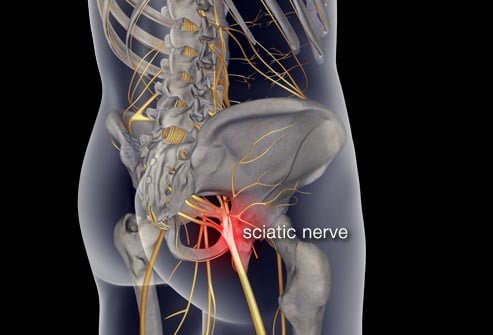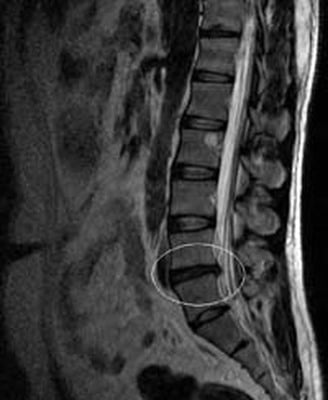SCIATICA
Cause, Symptom, Treatment

Is My Back Pain Sciatica?
Sciatica relates to a group of symptoms that happen when the left, or right sciatic nerve is compressed, injured or inflamed. The sciatic nerves are the largest nerves in the body. They branch from the spinal cord in the lower lumbosacral region or back and run through the buttocks and down the legs. The sciatic nerves and their branches are responsible for both movement and sensation in the legs and feet.
Injury, compression, or inflammation of the sciatic nerve results in symptoms that typically include pain anywhere along the nerve path through the buttock, leg and foot on the affected side. Weakness and numbness can also occur. There can be marked variability in the specific combination of motor and sensory symptoms. A common cause of sciatic nerve compression and inflammation is a herniated, or bulging, disk in the lower spine. Sciatic nerve compression can also be due to general wear and tear on the spine and the disks that cushion the vertebrae of the spine.
Sciatica is treatable. Treatment for sciatica varies depending on the severity of your symptoms, the presence of complications, your age and medical history, and the type of work and activities you perform.
Seek medical care if you experience symptoms of sciatica, such as pain that runs down the leg. Early diagnosis and treatment can reduce or eliminate symptoms and complications, such as loss of leg movement and disability. Seek immediate emergency care if you, or someone you are with, have loss of leg movement or sensation, or loss of bowel or bladder control (incontinence).
Cause
Causes of sciatica

Sciatica frequently occurs due to a bulging or herniated disk in the lower spine. This can pinch or put pressure on the sciatic nerve, which is responsible for movement and sensation in the legs and feet.
Other causes of sciatica include Degenerative disk disease (DDD), Osteoarthritis, Pregnancy, Spinal tumor (rare), Trauma to the spine or back.
Risk factors for sciatica
A number of factors increase the risk of developing sciatica. Risk factors include a genetic predisposition, age over 40, back injury, contact sports, degenerative spine disease, Obesity and being overweight, occupation that includes heavy lifting, bending, or twisting and using improper lifting techniques, sedentary lifestyle or occupation which can weaken the muscles that support the spine, smoking.
Reducing your risk of sciatica
You can lower your risk of developing sciatica by maintaining a healthy weight, participating in moderate exercise program’s that include stretching and core exercises. Strengthening the muscles of your abdomen and hamstrings, taking exercise breaks when sedentary (microbreaking) every 30 minutes, such as walking and stretching for 1 minute every half hour when working all day at a computer, using proper techniques or body mechanics when lifting heavy objects, ie. lift with legs not the back.
Symptom
Symptoms of sciatica
The type and severity of symptoms of sciatica vary among individuals. Certain activities, such as coughing, sneezing, movement of the back, or sudden movements, can make symptoms worse.
Symptoms of sciatica may include burning, numbness or tingling in the back, buttock, leg or foot, or pain in the back, buttock, leg or foot. Pain can shoot down from the lower back through the buttock and leg and into the foot. Pain may also occur in only one area of the lower extremity, such as above or below the knee, or manifest as weakness in the back, buttock, leg or foot.
Symptoms that may indicate a serious condition
In some patient’s, the cause of sciatica can be serious. Seek immediate medical care if you or someone you are with, cannot feel or move their lower extremity, or have a loss of bowel or bladder control (incontinence).
Treatment
Sciatic treatments in the Scranton area
Depending on the underlying cause of sciatica, a variety of treatments and therapies may be recommended including rest and physical restrictions. Chiropractic therapies, such as spinal adjustments, electrical stimulation, and spinal decompression therapy.
With early diagnosis and treatment at Back & Neck Care Chiropractic, it is possible to reverse the symptoms of sciatica in many cases. Treatment plans use a comprehensive approach individualized to the underlying cause, the severity of your symptoms, your medical history and general health, and other factors. Treatment also includes diagnosing and treating some underlying conditions that may be causing sciatica, such as herniated disk or osteoarthritis.
Treatment length can vary significantly between patients. Some respond very quickly while others take longer to recover. It can be dependant on a few things, such as; How long the condition has been present and the condition of the disc or the joints that the chiropractor has to correct. Mostly, the longer the issue has been present the longer it will take. The good news is that it normally takes less time to correct symptoms of sciatica than it took to create them.
If you are serious about turning your symptoms off and avoiding surgery, call chiropractor Alfred Canal in Dunmore PA Throop. We are here to answer any questions you have and look forward to helping you feel better.
Additional treatment options
Complementary therapies, such as yoga, acupuncture, and massage. Physical therapy and prescribed exercise to improve muscle strength in the hamstrings and abdomen, increase flexibility and movement, and reduce pain.
Medications used in the medical model to treat sciatica typically include Antidepressants, which is said to help to reduce nerve pain, corticosteroid medications, which might reduce inflammation and pain. Corticosteroids are generally given through direct injection into the spine. Muscle relaxants, which may ease muscle tension and pain, nonsteroidal anti-inflammatory drugs (NSAIDS), such as ibuprofen (Advil, Motrin) and naproxen (Aleve, Naprosyn), which help to control inflammation and pain. It has been reported the use of NSAIDs can cause serious, even life-threatening side effects in some people. Non-opioid pain drugs that work at the opioid receptor (Tramadol) for treatment of chronic sciatic pain, short-term opioids for relief of acute sciatic pain.
Surgery to relieve severe pain or to address bowel incontinence, bladder incontinence, or leg weakness. Surgery may also include diagnosing and treating other underlying conditions that may be causing sciatica, such as spinal tumor or osteoarthritis. Other surgical options for pain include laminectomy or discectomy, both of which may relieve pressure on the sciatic nerve. The number of people that under go surgery for back pain is astonishing with a low success rate for those without underlying complicating causes. Estimations are that back pain surgery is about 15% effective.
Sciatica complications
Complications of sciatica can have a profound effect on the ability to function in everyday life and can be permanently disabling in some cases. You can reduce the risk of serious complications of sciatica by following the treatment plan you and your health care professional design specifically for you.
Complications of sciatica include bladder incontinence, bowel incontinence, loss of leg movement, permanent disability, poor quality of life, adverse effects of treatment, pain medication addiction.
